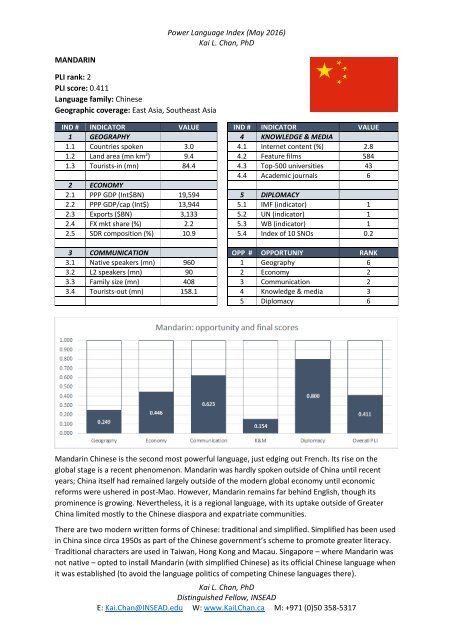POWER LANGUAGE INDEX
Kai-Chan_Power-Language-Index-full-report_2016_v2
Kai-Chan_Power-Language-Index-full-report_2016_v2
You also want an ePaper? Increase the reach of your titles
YUMPU automatically turns print PDFs into web optimized ePapers that Google loves.
Power Language Index (May 2016)<br />
Kai L. Chan, PhD<br />
MANDARIN<br />
PLI rank: 2<br />
PLI score: 0.411<br />
Language family: Chinese<br />
Geographic coverage: East Asia, Southeast Asia<br />
IND # INDICATOR VALUE IND # INDICATOR VALUE<br />
1 GEOGRAPHY 4 KNOWLEDGE & MEDIA<br />
1.1 Countries spoken 3.0 4.1 Internet content (%) 2.8<br />
1.2 Land area (mn km 2 ) 9.4 4.2 Feature films 584<br />
1.3 Tourists-in (mn) 84.4 4.3 Top-500 universities 43<br />
4.4 Academic journals 6<br />
2 ECONOMY<br />
2.1 PPP GDP (Int$BN) 19,594 5 DIPLOMACY<br />
2.2 PPP GDP/cap (Int$) 13,944 5.1 IMF (indicator) 1<br />
2.3 Exports ($BN) 3,133 5.2 UN (indicator) 1<br />
2.4 FX mkt share (%) 2.2 5.3 WB (indicator) 1<br />
2.5 SDR composition (%) 10.9 5.4 Index of 10 SNOs 0.2<br />
3 COMMUNICATION OPP # OPPORTUNIY RANK<br />
3.1 Native speakers (mn) 960 1 Geography 6<br />
3.2 L2 speakers (mn) 90 2 Economy 2<br />
3.3 Family size (mn) 408 3 Communication 2<br />
3.4 Tourists-out (mn) 158.1 4 Knowledge & media 3<br />
5 Diplomacy 6<br />
Mandarin Chinese is the second most powerful language, just edging out French. Its rise on the<br />
global stage is a recent phenomenon. Mandarin was hardly spoken outside of China until recent<br />
years; China itself had remained largely outside of the modern global economy until economic<br />
reforms were ushered in post-Mao. However, Mandarin remains far behind English, though its<br />
prominence is growing. Nevertheless, it is a regional language, with its uptake outside of Greater<br />
China limited mostly to the Chinese diaspora and expatriate communities.<br />
There are two modern written forms of Chinese: traditional and simplified. Simplified has been used<br />
in China since circa 1950s as part of the Chinese government’s scheme to promote greater literacy.<br />
Traditional characters are used in Taiwan, Hong Kong and Macau. Singapore – where Mandarin was<br />
not native – opted to install Mandarin (with simplified Chinese) as its official Chinese language when<br />
it was established (to avoid the language politics of competing Chinese languages there).<br />
Kai L. Chan, PhD<br />
Distinguished Fellow, INSEAD<br />
E: Kai.Chan@INSEAD.edu W: www.KaiLChan.ca M: +971 (0)50 358-5317


